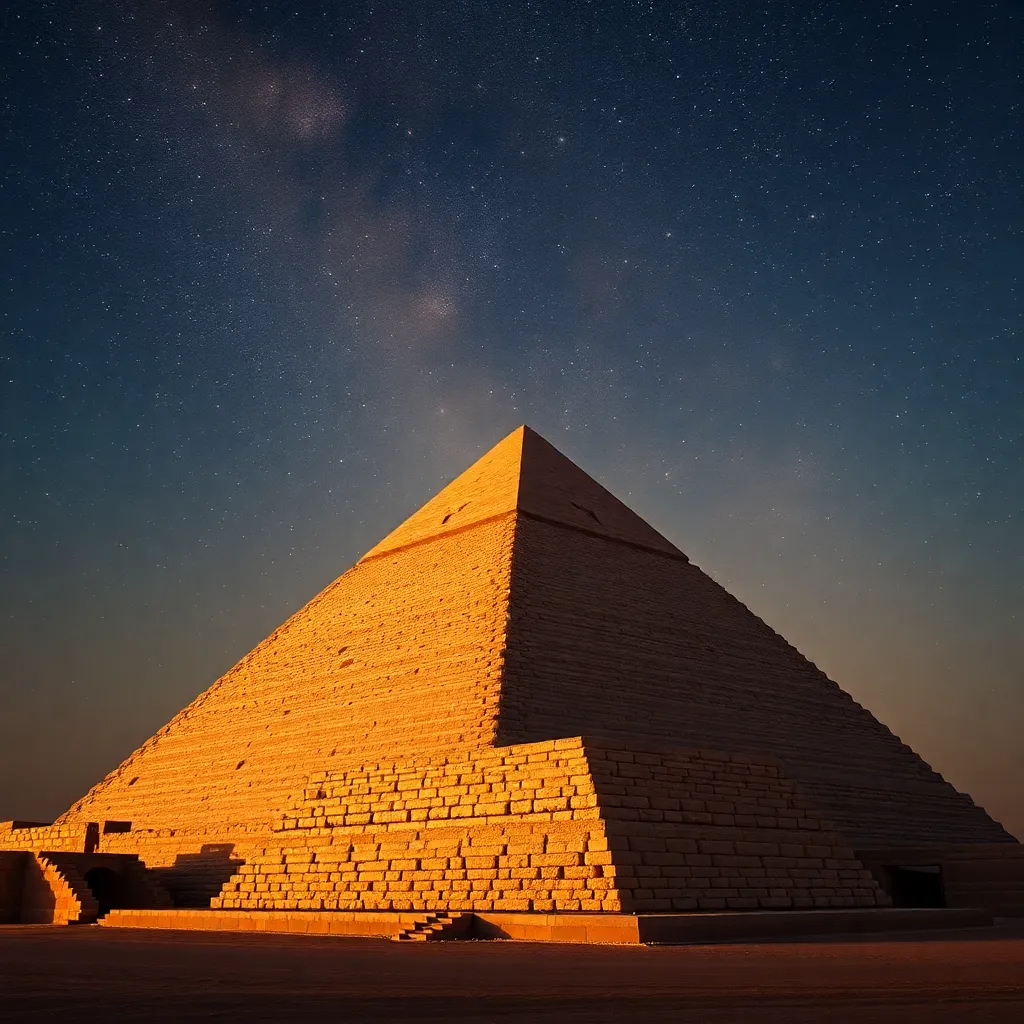The Great Pyramid’s Alignment with the Stars
I. Introduction
The Great Pyramid of Giza, one of the most iconic monuments of ancient Egypt, stands as a testament to the architectural prowess of the civilization that built it. Constructed over 4,500 years ago, it continues to captivate historians, archaeologists, and visitors alike. One of the most intriguing aspects of this monumental structure is its precise astronomical alignments, showcasing the ancient Egyptians’ profound understanding of the cosmos.
Astronomical alignments played a vital role in ancient architecture, often reflecting the beliefs and practices of the societies that constructed these edifices. The purpose of this article is to delve into the remarkable alignment of the Great Pyramid with celestial bodies, exploring how these alignments were integral to the cultural and religious life of ancient Egypt.
II. Historical Context of the Great Pyramid
The Great Pyramid was built during the Fourth Dynasty of the Old Kingdom, around 2580–2560 BC, under the reign of Pharaoh Khufu, also known as Cheops. It served as his tomb and was part of a larger complex that included smaller pyramids, temples, and mortuary structures. The pyramid originally stood at 146.6 meters (481 feet) tall, making it the tallest man-made structure in the world for over 3,800 years.
In ancient Egyptian culture, the pyramid symbolized the pharaoh’s journey to the afterlife. The Egyptians believed in a complex afterlife where the deceased would be judged and, if deemed worthy, would ascend to the stars. The alignment of the pyramid with celestial bodies was thought to facilitate this journey, linking the earthly realm with the divine.
III. Celestial Bodies and Their Importance in Ancient Egypt
In ancient Egypt, celestial bodies held immense significance, influencing various aspects of life and belief. Key celestial bodies included:
- The Sun: Central to Egyptian religion, worshipped as Ra, the sun god.
- The Moon: Associated with Thoth, the god of wisdom and writing.
- Stars: Particularly the stars of Orion and Sirius, which were linked to Osiris and Isis, respectively.
The stars played a crucial role in navigation and timekeeping. Egyptian farmers relied on the heliacal rising of Sirius to predict the annual flooding of the Nile, which was essential for agriculture.
IV. The Great Pyramid’s Astronomical Alignments
The Great Pyramid is remarkably oriented to true north, with an accuracy of just 0.5 degrees. This precise alignment has intrigued researchers for centuries. One of the most notable alignments is with Orion’s Belt, a constellation that the ancient Egyptians associated with Osiris, the god of the afterlife.
The pyramid’s layout also aligns with other key stars, which were vital in the ancient Egyptians’ religious beliefs. The significance of these alignments can be summarized as follows:
- Spiritual Connection: The alignment with Orion’s Belt symbolized the pharaoh’s connection to Osiris.
- Navigation for the Afterlife: The stars were seen as guides for the deceased in their journey to the afterlife.
- Cosmic Order: The alignment represented the Egyptians’ understanding of cosmic order and harmony.
V. Theories Behind the Pyramid’s Alignment
Numerous theories have been proposed regarding the methods used by the ancient Egyptians to achieve such precise astronomical alignments. Some of the most prominent theories include:
- Use of the Stars: Some archaeologists suggest that the Egyptians used the stars as a reference point, aligning the pyramid’s corners with key stars in the night sky.
- Shadow Casting: Another theory posits that the Egyptians may have utilized the casting of shadows to determine true north.
- Geodetic Techniques: The advanced understanding of geometry and astronomy in ancient Egypt could have played a role in achieving these alignments.
Comparisons with other ancient structures, such as Stonehenge and the Mayan pyramids, reveal similar astronomical considerations, suggesting a widespread ancient practice of aligning structures with celestial bodies.
VI. Modern Scientific Investigations
In recent years, technological advancements have allowed for deeper investigations into the Great Pyramid’s alignment. Techniques such as:
- Laser Scanning: High-precision laser tools provide detailed measurements of the pyramid’s orientation.
- Satellite Imagery: Modern satellite technology allows researchers to analyze the pyramid’s position concerning other celestial markers.
- Computer Simulations: Advanced modeling software helps recreate ancient sky conditions to assess alignment accuracy.
Recent findings have reinforced the understanding that the pyramid’s orientation was not accidental but rather a deliberate and intricate aspect of its design, reflecting the Egyptians’ sophisticated knowledge of astronomy.
VII. Cultural Impact and Legacy
The Great Pyramid of Giza stands as a powerful symbol of ancient engineering and astronomical knowledge. Its influence extends beyond the realm of archaeology and history:
- Modern Architecture: The pyramid’s design has inspired countless architectural works, symbolizing strength and endurance.
- Cultural Perspectives: The pyramid continues to shape how we view the intersection of astronomy and cultural beliefs.
- Preservation Efforts: Ongoing research and preservation initiatives aim to protect this world heritage site for future generations.
VIII. Conclusion
The alignment of the Great Pyramid with the stars is not merely an architectural feat; it embodies the ancient Egyptians’ deep spiritual beliefs and understanding of the cosmos. This remarkable structure serves as a bridge between the earthly and the divine, reflecting a society that revered the stars and sought to connect with the afterlife.
As we explore the wonders of ancient civilizations, the Great Pyramid remains a focal point for understanding the intricate relationship between architecture, astronomy, and belief systems. Further research and exploration will undoubtedly continue to unveil the mysteries of this monumental structure and its celestial alignments.




